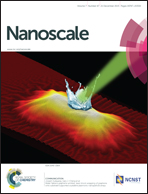Selective nanomanipulation of fluorescent polystyrene nano-beads and single quantum dots at gold nanostructures based on the AC-dielectrophoretic force†
Abstract
We introduced the selective manipulation of polystyrene (PS) nano-beads and single quantum dots (QDs) at a gold nanostructure by using the AC-dielectrophoretic (DEP) force. Manipulation in three degrees of freedom (end-facet, side, and position-selective manipulation) was accomplished in gold nanostructures between microelectrodes. A 10 μm gap between the microelectrodes, which has a 100 nm-wide nanowire and 200 nm-wide vortex nanostructures at the inside of the gap, was fabricated, and nanostructures were not connected with the electrodes. We also performed theoretical calculations to verify the selective manipulation through the floating AC-DEP force. A sufficiently high gradient of the square of the electric field (∇|E|2, ∼1019 V2 m−3) was accomplished and controlled for achieving a strong attaching force of nanoparticles using the gap between microelectrodes and nanostructures as well as the rotation of structures. Fluorescent PS nano-beads and QDs were attached at the designed end facet, side, and position of nanostructures with high selectivity. A single QD attachment was also realized at gold nanostructures, and the attached QDs were verified as single using optical “blinking” measurements.



 Please wait while we load your content...
Please wait while we load your content...